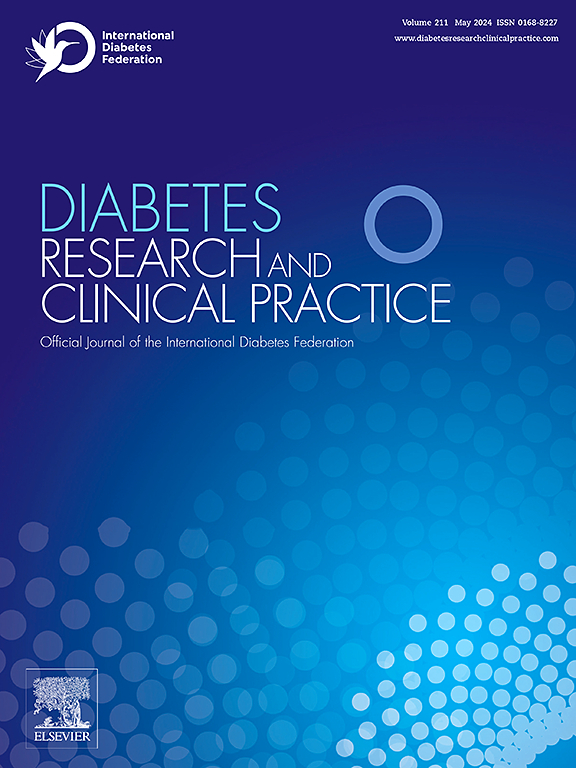Association between hemoglobin, albumin, lymphocyte, and platelet score and all-cause and cardiovascular mortality among population with diabetes: Evidence from the NHANES 2003–2016
IF 6.1
3区 医学
Q1 ENDOCRINOLOGY & METABOLISM
引用次数: 0
Abstract
Introduction
This study investigated the relationship between the Hemoglobin, Albumin, Lymphocyte, and Platelets (HALP) score and all-cause and cardiovascular mortality risk in diabetes patients.
Methods
An analysis included 2154 individuals with diabetes from the 2003–2016 National Health and Nutrition Examination Survey (NHANES), with mortality data tracked until December 31, 2019. Cox regression models were adopted to evaluate the association of HALP score with mortality. The nonlinear relationship was examined using restricted cubic splines (RCS), and a two-segmented Cox proportional risk model analyzed data around identified threshold values.
Results
During a median follow-up of 90 months, 565 (26.23 %) deaths occurred, of which 166 (7.71 %) caused by cardiovascular disease. In the Cox regression models, participants in the highest quartile of HALP score had lower risks of all-cause mortality (HR = 0.59,95 % CI:0.43–0.83, p = 0.002) and cardiovascular mortality (HR = 0.38,95 % CI:0.22–0.66, p < 0.001) compared to the lowest quartile. Based on the restricted cubic splines (RCS) curve, a L-shaped relationship was found, with thresholds of 49.81 for all-cause and 48.78 for cardiovascular mortality. HALP scores below these thresholds were associated with increased mortality (p < 0.001).
Conclusion
HALP score may serve as a valuable clinical indicator for predicting mortality risk in diabetes patients.
糖尿病人群中血红蛋白、白蛋白、淋巴细胞和血小板评分与全因死亡率和心血管死亡率之间的关系:来自NHANES 2003-2016的证据
本研究探讨了糖尿病患者血红蛋白、白蛋白、淋巴细胞和血小板(HALP)评分与全因和心血管死亡风险的关系。方法分析了2003-2016年全国健康与营养调查(NHANES)中的2154名糖尿病患者,死亡率数据追踪至2019年12月31日。采用Cox回归模型评价HALP评分与死亡率的相关性。使用限制三次样条(RCS)检验非线性关系,并使用两段Cox比例风险模型分析识别阈值周围的数据。结果中位随访90个月,死亡565例(26.23%),其中心血管疾病死亡166例(7.71%)。在Cox回归模型中,HALP评分最高的四分位数参与者的全因死亡率(HR = 0.59, 95% CI: 0.43-0.83, p = 0.002)和心血管死亡率(HR = 0.38, 95% CI: 0.22-0.66, p <;0.001),与最低四分位数相比。基于限制性三次样条(RCS)曲线,发现l型关系,全因死亡率阈值为49.81,心血管死亡率阈值为48.78。HALP评分低于这些阈值与死亡率增加相关(p <;0.001)。结论halp评分可作为预测糖尿病患者死亡风险的一个有价值的临床指标。
本文章由计算机程序翻译,如有差异,请以英文原文为准。
求助全文
约1分钟内获得全文
求助全文
来源期刊

Diabetes research and clinical practice
医学-内分泌学与代谢
CiteScore
10.30
自引率
3.90%
发文量
862
审稿时长
32 days
期刊介绍:
Diabetes Research and Clinical Practice is an international journal for health-care providers and clinically oriented researchers that publishes high-quality original research articles and expert reviews in diabetes and related areas. The role of the journal is to provide a venue for dissemination of knowledge and discussion of topics related to diabetes clinical research and patient care. Topics of focus include translational science, genetics, immunology, nutrition, psychosocial research, epidemiology, prevention, socio-economic research, complications, new treatments, technologies and therapy.
 求助内容:
求助内容: 应助结果提醒方式:
应助结果提醒方式:


